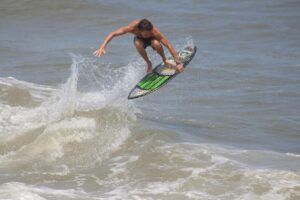How should you choose and buy a skimboard?
You’ll also need to pick a board that is appropriate for your weight and skill level. In the end, it all comes down to how much speed you can bring into the water or ground.
Beginners should start out on a wet, flatland surface. Later, obstacles and shore breaks should be introduced.
Keep in mind that skimboarding is a fun activity, but you should always adhere to basic safety measures to ensure your safety and the safety of others.
The conversion from kilograms (kg) to pounds (lb) is as follows: 1 kilogram weighs 2.2 pounds. To convert meters (m) to feet (ft), divide 3.3 by 1.
Take a peek at the skimboard size chart to see what your options are:
Skimboarder Weight (lb)
< 80
80-100
100-140
120-160
140-180
160-200
180-220
200-240
Skimboard Model (size)
XXS
XS
S
M
ML
L
XL
XXL
Skimboard Dimensions (inches)
45.00” x 19.00”
48.00” x 19.25”
51.00” x 19.75”
52.00” x 20.00”
52.25” x 20.25”
52.50” x 20.50”
53.00” x 20.75”
54.00” x 21.50”
How do you choose the right Skimboard?
Size
What is the best method to select a skimboard? Is there a board that is perfect for my weight?
A large skimboard, for example, will be quick but will not carve quickly if you need to attack a falling wave lip as a general rule.
On the other side of the spectrum, a tiny board is “shy” and slower. In other words, it will respond swiftly to slight body adjustments, but it will not be as quick as a bigger board.
Rule of thumb number two: Choose a skimboard that is about mid-chest height.
Skimboards come in a variety of heights (from 45.00 to 57.00 inches) and widths (17.75 to 23.00 inches), depending on the rider’s physical characteristics, experience, and type of ride (waves or flat waters/surfaces).
Thickness, Tail and Shapes
The skimboard’s behavior is greatly impacted by the thickness of its deck.
Skimboards with a medium-weight core are excellent all-arounders. They won’t turn and carve as well as skimboards with a lightweight core, but they’ll float and glide better.
The control of smaller sized models is more difficult at full speed, but they enable you to execute acrobatic moves without difficulty.
If you have a lot of rocker on your board, it will be moves slower in high winds and can be easily picked up.
The pintail is the most popular tail style in skimboards because it improves overall performance.
Skimboards come in a variety of forms. There is no set rule for skimboard shapes.
Always keep in mind that wave skimboarding and flatland skimboarding are two separate sports.
Nonetheless, a wider template is ideal for flatland and speed, while big tails and noses are made to spin fast and excel in obstacles and small waves.
There are four basic rocker types: continuous, hybrid, three-stage, and five-stage.
Skimmers develop their own shapes, so it’s critical to verify the dimensions of their skimboards.
Victoria Skimboards, Zap Skimboards, Exile Skimboards, DB Skimboards, and Wave Zone Skimboards are the most popular skimboard producers.
If you go all in and take a chance, the safe option is to size up.
Types of Skimboards
Skimboards come in a variety of core materials. Wood, carbon fiber, Kevlar, fiberglass/foam, and graphite are all possible choices.
Beginners should purchase a wood or graphite plank for their first board. They’re cheap, and they’ll allow new skimmers to get comfortable with the fundamental skimming movements and procedures.
Flatland skateboarders, on the other hand, prefer carbon fiber and wood-based skimboards.
Inland skimboarders normally employ heavy, robust wood planks because they are heavier and far more durable.
For individuals who enjoy surfing both waves and flat inland terrain, fiberglass/foam boards might be a good compromise.
Quaker is a type of sporty sandal that has a lot of bounce. They’re also popular among wave riders since they provide more floatation.
